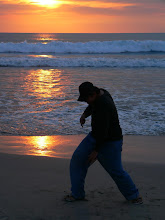My first surprise came when one application asked me to make sure that my date and time settings were correct. I dutifully popped into System Preferences, clicked on the Date & Time preferences pane, clicked on the Time Zone tab, and noticed a couple of things that were different:

First, the time zone I'm in (Mountain) was highlighted and as I moved my cursor left and right, a "ghost" appeared for whatever time zone I was currently over (see arrow above). That in itself wasn't anything great, but the check box at the top -- Set time zone automatically using current location (see oval above) -- was intriguing so I clicked on it. The map went to shades of gray, and then Snow Leopard used the
SkyHook Wireless's Wi-Fi positioning service to figure out where I was.

This will be wonderful when I'm traveling for business or pleasure, as I no longer have to remember to set my local time zone when I arrive at a new location. Of course, it's not going to be very useful if you're in an area with little or no Wi-Fi...
The second cool feature was one that was pointed out by resident boy genius
Brett Terpstra. It's the text substitution feature that's tucked away in System Preference -- Language & Text. What you can do is set up system-wide text substitutions for various shortcuts. For example, I set one up that uses the letters "sl" as a shortcut for "Mac OS X 10.6 Snow Leopard." In any of the apps that use these text substitutions, I just need to type "sl" and I get the whole enchilada.

This doesn't work in a lot of applications, unfortunately, but it's fun to use where it does work. In Mail.app, iChat, TextEdit, and a handful of other apps, I was able to turn on text substitution from the Edit menu. These apps then used the shortcuts I had set up in the Language & Text sysprefs panel to speed up typing.
My personal favorite tip involves stacks in the Dock. Stacks are the folders that usually end up in the lower right corner of the dock. I usually set up my Macs with three stacks in the Dock -- downloads, documents, and applications. Now I can use my application stack as a type of quick launcher. A click on the stack brings up the grid icon view of the apps, and I just type the first couple of letters of the application name, then press return to launch it.
QuickTime X also has a few nice new features. In playback, the FF / Rew buttons "stick", and if you want to go backwards or forwards through your video even faster, you click on those buttons again to accelerate the motion. I really like the screen recording feature found under the File menu as well, since it's a very fast way to create spur-of-the-moment screencasts for friends or clients.
This next one might have been something you could do in earlier versions of Mac OS X, but it's new to me. A reader pointed out that if you option-click on the sync icon in the menu bar, you now get a complete sync history as well as some sync diagnostics and a way to reset sync history without having to fire up iSync:

The final tip has nothing to do with actually running Snow Leopard...or does it? TUAW reader Jared A. reminded us that the music played at the end of the Snow Leopard installation (which also appeared in Leopard) is the song "Exodus Honey" by Honeycut.
It's available in the iTunes Store.


 One of the little frustrations in my everyday use of
One of the little frustrations in my everyday use of  There's been
There's been 



 Munster noted that having multiple carriers in a market has helped Apple to achieve greater success in terms of market penetration. He pointed to France as an example; originally, Apple inked an exclusive arrangement with Orange. When it moved to a multi-carrier deal, Apple's market share in France jumped to about the 40 percent range. In the U.S., the iPhone's market share is only in the mid-teens.
Munster noted that having multiple carriers in a market has helped Apple to achieve greater success in terms of market penetration. He pointed to France as an example; originally, Apple inked an exclusive arrangement with Orange. When it moved to a multi-carrier deal, Apple's market share in France jumped to about the 40 percent range. In the U.S., the iPhone's market share is only in the mid-teens. Last night I received an email from a friend who was irate. He's been using his iPod touch as a portable video solution with a dock and video out cable. The iPod and the cable got along famously until he updated to
Last night I received an email from a friend who was irate. He's been using his iPod touch as a portable video solution with a dock and video out cable. The iPod and the cable got along famously until he updated to 



